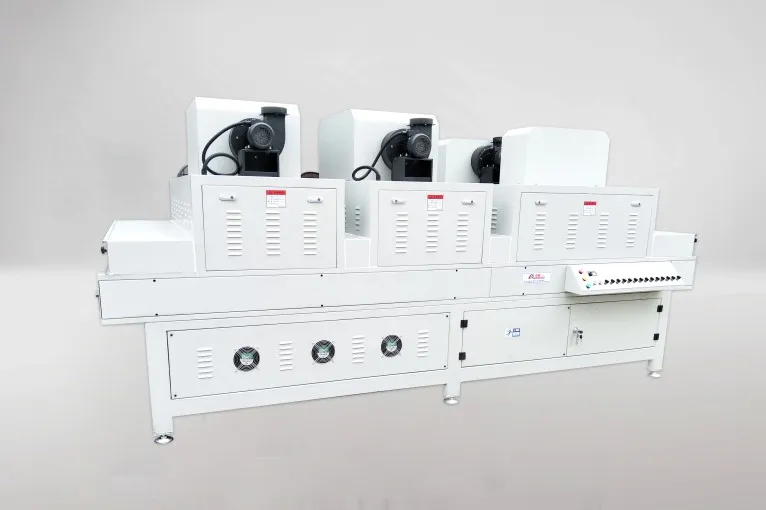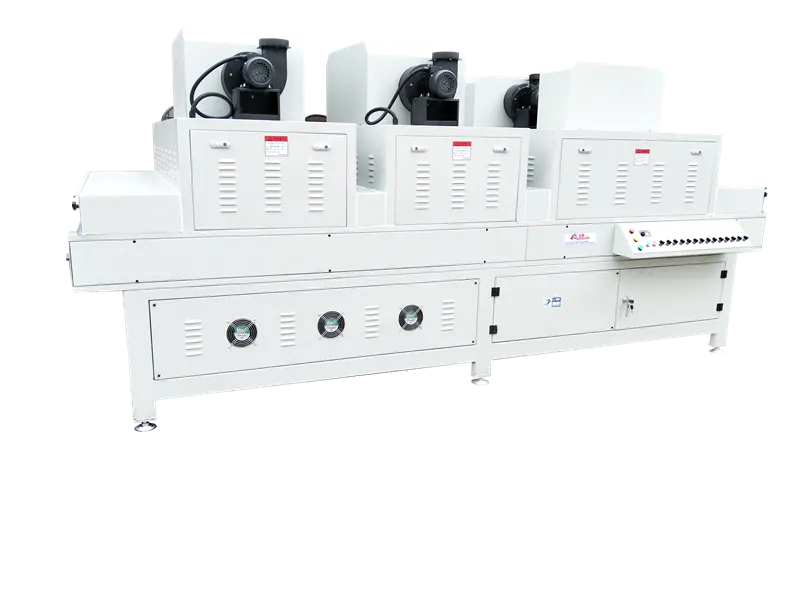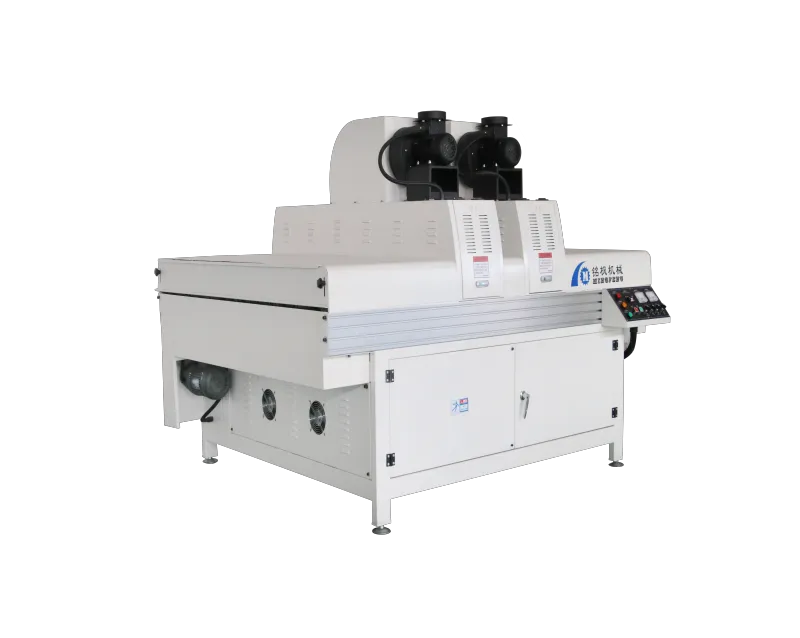A UV paint dryer machine is a specialized device that uses ultraviolet (UV) light to rapidly polymerize and cure paint, creating a wear-resistant, chemical-resistant, and glossy coating. Unlike traditional drying methods that rely on solvent evaporation or thermal energy, a UV paint dryer machine uses a photochemical reaction to quickly induce free radical or cationic polymerization of the paint's photoinitiators, achieving instant film formation.
UV curing technology, with its advantages of fast curing speed, low energy consumption, excellent coating performance, and small footprint, is widely used in surface treatment processes in industries such as wood, furniture, printing, plastics, glass, metal, and electronics.
How does a UV paint dryer machine work?
The core of a UV paint dryer machine is a chemical curing reaction initiated by UV light. Common UV coatings are composed of a resin (such as acrylates or polyurethane acrylates), a monomer/diluent, a photoinitiator, and functional fillers. During operation, a UV lamp emits ultraviolet light of a specific wavelength. This light energy is absorbed by the photoinitiator in the coating, generating free radicals or cations, which initiate rapid crosslinking and polymerization between monomers and oligomers, resulting in a cured coating film within seconds to tens of seconds. This process does not rely on solvent evaporation, resulting in high solids content, low VOC emissions, and rapid film formation.
Key Terms:
• Irradiance: The light power received per unit area, commonly expressed in mW/cm².
• Light Dose: The product of irradiance and time, commonly expressed in J/cm² (= mW/cm² × s/1000).
• Wavelength (nm): Different photoinitiators have different wavelength sensitivities. Commonly used UV bands include UV-A (315–400 nm), UV-B (280–315 nm), and UV-C (100–280 nm). Industrial UV curing primarily uses the 200–420 nm range, while LED-UV primarily uses wavelengths such as 365, 385, 395, and 405 nm.

What are the main components of a UV paint dryer machine?
A complete UV paint dryer machine typically includes the following modules:
1. UV light source module
• Traditional mercury lamps (medium- and low-pressure mercury lamps, mercury-halogen lamps, mercury/xenon lamps, etc.) or LED-UV modules.
• Equipped with reflectors and wavelength filters (to filter out harmful wavelengths or improve the efficiency of targeted wavelengths).
2. Lamp chamber and reflector system
• A high-reflectivity mirror reflector or optical reflective material is used to effectively focus the light emitted by the lamp on the workpiece surface, improving utilization efficiency.
3. Conveyor system
• A belt, roller, or chain conveyor transports the workpiece to be cured through the lamp chamber at a stable, high-speed. The speed is adjustable to control exposure time.
4. Heat Dissipation and Cooling System
• Air or water cooling (mercury lamps particularly require water cooling to extend their lifespan); LEDs generally use air cooling or passive cooling. The cooling system also protects the substrate from high-temperature damage.
5. Exhaust and Exhaust Gas Treatment System
• Extracts volatile substances and ozone generated by the lamp and purifies them with activated carbon or a catalytic device.
6. Control System
• PLC or industrial controller, responsible for controlling parameters such as lamp power, transmission speed, fault alarms, temperature monitoring, and light intensity monitoring.
7. Safety and Interlock Devices
• Optical shielding, protective door interlocks, emergency stop button, UV leak detection, and audible and visual alarms.
8. Testing Equipment (Optional)
• UV radiometer, energy meter, temperature and wind speed sensors for process monitoring and verification.

UV Paint Dryer Machine: UV Light Source Types and Comparison
UV paint dryer light sources mainly include traditional mercury lamps and LED-UV, each with its own characteristics and application scenarios.
1. Traditional Mercury Lamp (Low-Pressure/Medium-Pressure Mercury Lamp, Mercury Halogen/Xenon Lamp)
• Features: Continuous emission spectrum covering a wide wavelength range (200–400 nm), high energy density, high instantaneous power, and suitable for a variety of photoinitiators.
• Advantages: High compatibility with a variety of traditional photoinitiators; good cure penetration for thick coatings or coatings with good hiding properties.
• Disadvantages: Long start-up warm-up time, high energy consumption, high heat generation, requirement for water cooling (or forced air cooling), generation of ozone and harmful wavelengths (which require filtration), limited lamp life (hundreds to thousands of hours), and decreased efficiency over time.
2. LED-UV
• Features: Primarily emits specific wavelengths (such as 365/385/395/405 nm), uses a semiconductor light source, and starts instantly, requiring no preheating.
• Advantages: Low energy consumption, long life (tens of thousands of hours), instant start and stop, minimal thermal impact, mercury-free and environmentally friendly, low ozone generation, and suitable for heat-sensitive materials. The equipment is compact and easily adjustable.
• Disadvantages: Sensitive to wavelength selection, requiring the use of a compatible photoinitiator; single-point luminescence intensity and penetration are slightly weaker than those of medium-pressure mercury lamps, potentially limiting the curing of thick or high-opaque coatings.
Selection Tips: If the coating formulation is LED-curable (the photoinitiator is sensitive to 395 nm) and the substrate is heat-sensitive, LED-UV is preferred. If the coating requires high opacity or strong penetration, mercury lamps still have advantages.

UV Paint Dryer Machine: Key Process Parameters and Controls
UV curing performance is determined by a combination of multiple parameters. Understanding and controlling these parameters is essential for ensuring stable output from a UV paint dryer machine.
1. Irradiance
This parameter affects the intensity of energy input per unit time. Measured in mW/cm². High irradiance shortens exposure time, but may result in over-curing of the surface layer while leaving the inner layer uncured (skinning), causing internal stress or surface defects.
2. Energy Density/Dose
Energy Density = Irradiance × Exposure Time (J/cm²). The completion of the curing reaction is primarily determined by the total dose, which must meet the threshold specified by the coating manufacturer.
3. Exposure Time and Conveyor Speed
The actual exposure time of the coating can be modified by adjusting the conveyor speed. Equipment design must ensure stable, vibration-free conveyor transport.
4. Lamp Distance/Uniformity
The distance between the lamp and the workpiece affects the irradiance distribution and intensity; at the same time, uniformity of light intensity in both the horizontal and vertical directions must be maintained to prevent color or hardness variations.
5. Thermal Management (Temperature Control)
UV curing involves a certain amount of heat release, especially with mercury lamps. Controlling the chamber temperature prevents thermal deformation of the substrate, abnormal volatilization of the coating, or accelerated degradation of the photoinitiator.
6. Air/Atmosphere
Some free radical curing systems are sensitive to oxygen (oxygen can terminate free radical polymerization). Therefore, an inert gas blanket (nitrogen replacement) can be used to increase the coating cure rate or achieve better surface properties. Nitrogen blanketing is often used, particularly when high light levels or high hardness are required.
7. Wavelength Matching
Ensuring that the light source emission wavelength matches the absorption peak of the coating photoinitiator is key to achieving satisfactory curing performance.
UV paint dryer machine: Compatibility of coatings and substrates
Not all coatings are suitable for UV curing, and not all substrates can withstand the physical and thermal stresses of a UV dryer.
1. Types of coatings suitable for UV curing
• Photopolymerizable acrylics (Acrylate): The most common, with fast curing speeds and adjustable properties.
• Polyurethane acrylates (PUA): Offer flexibility and weather resistance, widely used in wood and furniture.
• Photoinitiated epoxy/cationic systems: Utilize different crosslinking mechanisms and are suitable for certain specialty materials.
• UV varnishes, UV printing inks, and UV adhesives.
Coating labels should clearly state "UV curing" or "LED-UV compatible" and provide recommended energy density and wavelength ranges.
2. Substrate Compatibility
• Heat-sensitive materials (such as certain plastics and veneer): Low-heat LED-UV solutions are more suitable; high-heat mercury lamps should be used with caution.
• Transparent or translucent materials: Consider penetration depth and dye absorption when UV rays can penetrate and cure the interior coating.
• Metal and glass: They are generally heat-stable and well-suited for UV curing, but surface degreasing and pretreatment are still important to improve adhesion.
3. Surface Preparation Requirements
Good surface cleaning, degreasing, and priming, as well as appropriate pre-drying or primer coating, can significantly impact the adhesion and appearance of the final coating.
UV paint dryer machine: Quality Inspection and Common Troubleshooting
Common inspection items in the UV curing process include: adhesion (pull-off or cross-cut test), surface hardness (pencil hardness, pendulum hardness), scrub resistance, gloss, surface tack test (touch), film thickness measurement, and solvent resistance test.
Common Troubleshooting Methods
1. Surface is not cured or sticky
• Possible Causes: Insufficient irradiation energy (inadequate irradiance or time), mismatch between photoinitiator and light source, coating formulation issues, and thick film skinning.
• Treatments: Increase energy density, switch to a light source with a matching wavelength, reduce coating thickness or cure in layers, or modify the formulation.
2. Surface Yellowing or Discoloration
• Possible Causes: High-temperature oxidation, photoinitiator decomposition or coating additive reaction, oil release from the substrate.
• Treatment: Reduce lamp temperature, switch to a low-yellowing formulation, and strengthen substrate pretreatment.
3. Film Cracking or Brittleness
• Possible Causes: Excessive curing rate, high internal stress, differences in thermal expansion coefficients between the substrate and coating, or excessive crosslink density in the formulation.
• Treatment: Reduce peak irradiance or staged curing, adjust formulation flexibility, or introduce flexible monomers.
4. Uneven Light Intensity Leading to Color or Hardness Variations
• Possible Causes: Lamp aging, reflector contamination, lamp spacing or conveyor misalignment, and problems with light bar alignment.
• Treatment: Clean the reflector, replace or adjust the lamp, and calibrate the conveyor and uniformity design.
UV Paint Dryer Machine: Key Points for Selection and Purchasing
When selecting a UV paint dryer machine, consider the following practical considerations:
1. Process Requirements: Coating type, required energy density, exposure time per piece, and production cycle time.
2. Substrate characteristics: thermal sensitivity, surface topography, and light transmittance.
3. Light source type: LED-UV, mercury lamp, or a hybrid solution, determined by the coating formulation and heat dissipation requirements.
4. Chamber and conveyor design: Irradiation uniformity, speed range, and conveyor stability.
5. Cooling and exhaust capacity: Whether temperature control and pollutant removal compliance are guaranteed.
6. Safety and inspection: Whether online light intensity monitoring, energy meters, interlocks, and protective measures are provided.
7. Maintenance and service: Lamp replacement, spare parts supply, manufacturer technical support, and training.
8. Energy consumption and total cost: Consider not only the purchase price but also energy consumption, consumables (lamps, reflectors), maintenance costs, and lifecycle.
What geographic markets does XMF Machinery serve?
XMF Machinery has a global sales footprint, serving clients across Southeast Asia, the Middle East, Africa, and beyond. Our reputation as a dependable coating equipment manufacturer has enabled us to establish long-term partnerships worldwide. Buyers seeking high-quality machines with competitive prices and excellent technical support choose XMF Machinery as their trusted supplier.
